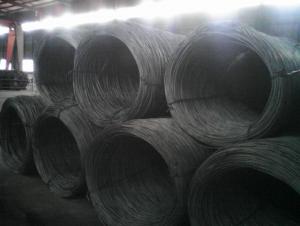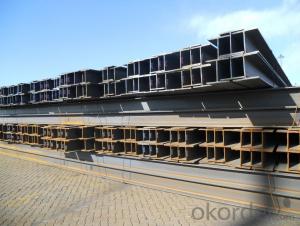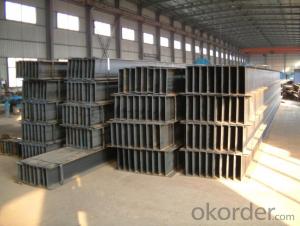GB Standard Steel H Beam 394-414mm with High Quality
- Loading Port:
- China main port
- Payment Terms:
- TT or LC
- Min Order Qty:
- 40 m.t
- Supply Capability:
- 15000 m.t/month
OKorder Service Pledge
OKorder Financial Service
You Might Also Like
Specifications of GB Standard Steel H Beam 394-414mm with High Quality For Sale:
1. Standard: GB Standard
2. Grade: Q235
3. Length: 12m
Size and Mass:
| Size (mm) | Mass (Kg/m) | Size (mm) | Mass (Kg/m) |
| 394*398*11.0 | 147 | 400*408*21.0 | 197 |
| 400*400*13.0 | 172 | 414*405*18.0 | 232 |
Usage & Applications of GB Standard Steel H Beam 394-414mm with High Quality For Sale:
Commercial building structure ;Pre-engineered buildings; Machinery support structure; Prefabricated structure; Medium scale bridges; Ship-building structure.etc.
Packaging & Delivery of GB Standard Steel H Beam 394-414mm with High Quality for Building Structures:
1. Packing: it is nude packed in bundles by steel wire rod
2. Bundle weight: not more than 3.5MT for bulk vessel; less than 3 MT for container load
3. Transportation: the goods are delivered by truck from mill to loading port, the maximum quantity can be loaded is around 40MTs by each truc4. If the order quantity cannot reach the full truck loaded, the transportation cost per ton will be little higher than full load.
4. Delivered by container or bulk vessel
Production flow of GB Standard Steel H Beam 394-414mm with High Quality:
Material prepare (billet) —heat up—rough rolling—precision rolling—cooling—packing—storage and transportation
FAQ:
Q1: Why buy Materials & Equipment from OKorder.com?
A1: All products offered byOKorder.com are carefully selected from China's most reliable manufacturing enterprises. Through its ISO certifications, OKorder.com adheres to the highest standards and a commitment to supply chain safety and customer satisfaction.
Q2: How do we guarantee the quality of our products?
A2: We have established an advanced quality management system which conducts strict quality tests at every step, from raw materials to the final product. At the same time, we provide extensive follow-up service assurances as required.
Q3: How soon can we receive the product after purchase?
A3: Within three days of placing an order, we will arrange production. The shipping date is dependent upon the quatity, how many sizes you want and the plan of production, but is typically 1 month to 2 month days from the beginning of production.
Images of GB Standard Steel H Beam 394-414mm with High Quality:


*If you would like to get our price, please inform us the size, standard/material and quantity. Thank you very much for your attention.
- Q: How do you calculate the torsional constant for steel H-beams?
- To calculate the torsional constant for steel H-beams, you need to consider the geometry and dimensions of the beam. The torsional constant, denoted as J, represents the resistance of the beam to torsional or twisting loads. The formula to calculate the torsional constant for an H-beam is given by: J = ((b1 * h1^3) + (b2 * h2^3))/3 Where: J = Torsional constant b1 = Flange width of the top flange h1 = Flange height of the top flange b2 = Flange width of the bottom flange h2 = Flange height of the bottom flange First, measure the dimensions of the H-beam, specifically the flange width and height for both the top and bottom flanges. Ensure that the measurements are in the same units, such as inches or millimeters. Next, substitute the measured values into the formula. Square the height values (h1 and h2) and cube the height values (h1^3 and h2^3). Multiply the appropriate flange width and the cubed height for each flange, and sum them together. Divide the result by 3 to obtain the torsional constant (J). It's important to note that the torsional constant assumes a uniform distribution of torsional stress across the section and neglects any warping effects. Therefore, it provides an approximate measure of the beam's resistance to torsion. For accurate results, it is recommended to consult relevant engineering specifications or perform detailed structural analysis using advanced software.
- Q: Are steel H-beams resistant to pests and insects?
- Yes, steel H-beams are highly resistant to pests and insects as they do not provide a suitable environment for them to inhabit or cause damage.
- Q: What are the different design considerations for steel H-beams in seismic zones?
- In seismic zones, the design considerations for steel H-beams are crucial to ensure the structural integrity and safety of buildings. Here are some of the key design considerations for steel H-beams in seismic zones: 1. Strength and Stiffness: Steel H-beams should possess adequate strength and stiffness to resist the dynamic forces induced during an earthquake. This involves selecting the appropriate steel grade and size of the H-beam to withstand the seismic loads. 2. Ductility: Ductility is the ability of a material to deform under stress without failure. In seismic zones, it is vital for steel H-beams to exhibit high ductility to absorb the energy generated by seismic forces. This can be achieved through proper detailing and reinforcing of the connections between the H-beams and other structural elements. 3. Connection Design: The connections between steel H-beams play a critical role in distributing seismic forces and ensuring the overall stability of the structure. These connections should be carefully designed to resist both vertical and lateral loads, and to allow for the necessary ductility during seismic events. 4. Anchorage: Steel H-beams need to be properly anchored to the foundation to prevent lateral displacement during an earthquake. Adequate anchor bolts or other anchoring systems should be employed to secure the H-beams to the supporting structure. 5. Fire Resistance: In addition to seismic considerations, steel H-beams should also be designed to withstand fire hazards. Fire-resistant coatings or fireproofing materials can be used to protect the H-beams from high temperatures, ensuring their structural integrity in case of a fire. 6. Design Codes and Standards: Designing steel H-beams in seismic zones requires adherence to specific codes and standards established by local building authorities. These codes provide guidelines on the minimum requirements for seismic design, including factors such as load combinations, material strengths, and detailing requirements. Overall, the design considerations for steel H-beams in seismic zones aim to ensure that the structural elements can effectively respond to and withstand the dynamic forces generated during an earthquake. By considering factors such as strength, stiffness, ductility, connection design, anchorage, and fire resistance, engineers can design steel H-beams that provide a safe and reliable structural system in seismic-prone areas.
- Q: How do steel H-beams perform in structures with uneven load distribution?
- When loads are distributed unevenly in a structure, causing concentration on specific areas rather than being evenly spread, the steel H-beams may be negatively impacted in terms of their performance. These H-beams are typically utilized to offer structural support and stability in buildings, bridges, and other large-scale constructions. In situations where load distribution is uneven, the steel H-beams may face difficulties. These beams are engineered to endure and evenly distribute loads, ensuring the overall integrity of the system. However, when the load is concentrated on a particular area, it can result in excessive stress being placed on the H-beams. Uneven load distribution can lead to several problems. Firstly, it can cause localized overloading, resulting in deformation, bending, or even failure of the H-beams. This can compromise the stability and safety of the structure as a whole. Additionally, uneven load distribution can impact the deflection and vibration characteristics of both the H-beams and the entire structure, potentially causing discomfort or damage to occupants or the structure itself. To minimize the effects of uneven load distribution on steel H-beams, proper structural design and engineering are crucial. Engineers must carefully analyze the loads and distribute them appropriately across the H-beams and other structural elements. This may involve reinforcing specific areas or redistributing the load through the use of additional supports or shifting the loads to other beams. Furthermore, the utilization of advanced materials or specialized beam designs, such as composite materials or tapered beams, can help enhance the performance of H-beams in structures with uneven load distribution. These advancements in materials and design can improve the load-bearing capacity and reduce potential issues caused by uneven load distribution. In conclusion, while steel H-beams are designed to perform effectively in structures with even load distribution, their performance can be compromised when faced with uneven loads. Proper design, engineering analysis, and potentially advanced materials and beam designs are essential in ensuring the optimal performance and safety of steel H-beams in structures with uneven load distribution.
- Q: Can steel H-beams be used in the construction of power plants?
- Yes, steel H-beams can be used in the construction of power plants. Steel H-beams are commonly used in construction due to their strength, durability, and ability to support heavy loads. In power plant construction, where structural integrity is crucial, steel H-beams are often used as structural elements for supporting large equipment, platforms, and structures, ensuring the stability and safety of the power plant.
- Q: Can steel H-beams be used in healthcare facilities and hospitals?
- Healthcare facilities and hospitals can utilize steel H-beams. These beams offer stability and structural support, making them appropriate for diverse construction endeavors, including healthcare facilities. Due to their robustness and resilience, steel H-beams are frequently employed in the construction of hospitals, clinics, and other healthcare structures. They possess the ability to bear substantial loads and establish a sturdy foundation for the entire edifice. Moreover, steel is a non-flammable substance, a crucial aspect in guaranteeing the safety of patients and staff within healthcare facilities. In summary, steel H-beams are a dependable and prevalent construction material within healthcare facilities and hospitals.
- Q: How do steel H-beams perform in high-rise buildings?
- Steel H-beams are commonly used in the construction of high-rise buildings due to their excellent performance under vertical loads and their ability to withstand high levels of tensile and compressive forces. These beams provide structural stability and support by distributing the building's weight evenly across their span, allowing for the construction of taller and more efficient structures. One of the key advantages of steel H-beams in high-rise buildings is their high strength-to-weight ratio. This means that they can support heavy loads while being relatively lightweight, making them ideal for constructing tall buildings where weight reduction is crucial. Additionally, steel H-beams have a high level of flexibility, allowing them to bend and deform under extreme loads without compromising the overall integrity of the structure. Furthermore, steel H-beams have excellent fire resistance properties, which is particularly important in high-rise buildings where fire safety is a paramount concern. Steel is inherently non-combustible and does not contribute to the spread of fire. Moreover, steel beams can be protected with fire-resistant coatings or encased in fire-resistant materials to enhance their fire resistance capabilities. In terms of construction efficiency, steel H-beams offer numerous benefits. They are prefabricated off-site, allowing for faster and more cost-effective installation. The uniformity and precision of the manufacturing process ensure consistent quality and dimensional accuracy. This leads to reduced construction time and labor costs, making steel H-beams a popular choice for high-rise buildings where time and cost savings are critical factors. Another advantage of using steel H-beams in high-rise buildings is their versatility. They can be easily customized and adapted to meet the specific design requirements of the structure. This flexibility allows architects and engineers to create innovative and aesthetically pleasing designs without compromising on structural integrity. Overall, steel H-beams are a reliable and efficient choice for high-rise buildings. Their high strength, fire resistance, construction efficiency, and versatility make them well-suited for withstanding the demanding conditions and loads experienced by tall structures.
- Q: What are the different surface coatings available for steel H-beams?
- Various surface coatings are available for steel H-beams, each offering unique benefits and protection. These coatings encompass the following options: 1. Paint: The most common and cost-effective coating for steel H-beams is paint. It creates a protective layer that prevents corrosion and can be customized with different colors or finishes. Periodic maintenance and touch-ups are necessary to maintain its effectiveness. 2. Galvanizing: A prevalent coating for steel H-beams is galvanizing, which involves applying a layer of zinc through hot-dip galvanization. This coating provides excellent corrosion resistance and is particularly suitable for outdoor applications or environments with high humidity or exposure to chemicals. 3. Powder Coating: Powder coating is an environmentally friendly and durable option for steel H-beams. It entails applying a dry powder that is then heated and fused into a smooth and protective layer. Powder coatings resist corrosion, chemicals, and UV rays, making them suitable for indoor and outdoor use. 4. Epoxy Coating: Epoxy coatings are commonly used in industrial or marine settings where superior chemical resistance is required. These coatings are applied in multiple layers and offer excellent protection against corrosion, abrasion, and impact. 5. Chrome Plating: Chrome plating involves depositing a thin layer of chromium onto the surface of steel H-beams. This coating provides exceptional corrosion resistance and a reflective, visually appealing finish. It is often used for decorative or high-end applications. 6. Thermal Spray Coatings: Thermal spray coatings encompass applying a molten material onto the steel H-beam surface using a specialized spraying process. The materials used can include zinc, aluminum, or ceramics, depending on the desired properties. Thermal spray coatings offer excellent corrosion resistance, thermal insulation, or wear resistance, depending on the material applied. When selecting a surface coating for steel H-beams, it is important to consider the specific application and environmental conditions. Consulting with a coatings specialist or manufacturer can help determine the most appropriate coating based on performance requirements, aesthetics, and budget.
- Q: How do steel H-beams compare to concrete beams in terms of cost and performance?
- Steel H-beams and concrete beams have different characteristics in terms of cost and performance. In terms of cost, steel H-beams tend to have a higher upfront cost compared to concrete beams. This is primarily because steel is a more expensive material than concrete. However, steel H-beams often have a longer lifespan and require less maintenance than concrete beams. This can lead to cost savings over the long term due to reduced repair and replacement costs. In terms of performance, steel H-beams offer several advantages over concrete beams. Steel has a higher strength-to-weight ratio, which means that steel beams can support larger loads with less material. This allows for greater design flexibility and potentially reduces the number of beams needed in a structure. Steel is also more resistant to fire and seismic activities, making it a preferred choice for structures in high-risk areas. Concrete beams, on the other hand, have their own advantages. Concrete is a readily available material and is often less expensive than steel in some regions. Concrete beams also have good resistance to corrosion and can withstand harsh environmental conditions. Additionally, concrete has excellent thermal properties, which can contribute to energy efficiency in buildings. In conclusion, while steel H-beams may have a higher initial cost compared to concrete beams, they offer superior performance in terms of strength, durability, and resistance to fire and seismic activities. However, concrete beams have their own advantages in terms of availability, cost, and thermal properties. The choice between steel H-beams and concrete beams ultimately depends on the specific requirements of the project, budget constraints, and local regulations.
- Q: How do steel H-beams compare to timber beams in terms of durability?
- When comparing steel H-beams to timber beams, it is commonly acknowledged that steel H-beams exhibit superior durability. This is primarily due to the fact that steel is a much stronger material capable of enduring higher loads and pressures in comparison to timber. Furthermore, steel is impervious to issues such as rot, decay, and insect infestation, which are frequently encountered problems with timber beams. In addition to these benefits, steel H-beams boast a longer lifespan and necessitate less maintenance when compared to their timber counterparts. Although timber beams may offer certain advantages in terms of cost and ease of installation, steel H-beams are the preferred option when considering long-term durability and structural integrity.
Send your message to us
GB Standard Steel H Beam 394-414mm with High Quality
- Loading Port:
- China main port
- Payment Terms:
- TT or LC
- Min Order Qty:
- 40 m.t
- Supply Capability:
- 15000 m.t/month
OKorder Service Pledge
OKorder Financial Service
Similar products
Hot products
Hot Searches
Related keywords




























